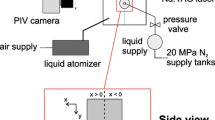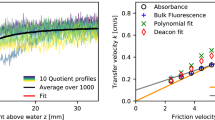Abstract
The mixing of two feed streams in a reactor, one with a fluorescent tracer, the other without, results in a fluctuating concentration field, due to the turbulent flow. Fluorescence spectroscopy allows the characterization of the fluctuations at small scale and high frequencies. Measurements have been made with a spatial resolution of about 30 μm and up to a frequency of 5,000 Hz. Methods have been developed to determine the variance (intensity of segregation) and the power spectra. The spectra can be used to calculate the integral scale of the fluctuations, and in some cases the microscale and dissipation rate. Two optical setups are presented, one based on a nonfocused and the other on a focused laser beam. It is shown that only the focused system has sufficiently high laser flux density and sufficiently small measurement volume to give useful results at the desired characteristic size and frequency. As a demonstration of the method, the turbulent mixing in a continuous stirred tank reactor has been studied. Experiments were carried out in a 225 cm3 baffled reactor, stirred by a six-bladed Rushton disk turbine. The effects of stirring speed and position on the mixing were investigated.
Similar content being viewed by others
Abbreviations
- C :
-
concentration, mol · m−3
- D :
-
stirrer diameter, m
- \(\mathfrak{D}\) :
-
diffusivity, m2 · s−1
- f :
-
frequency, Hz
- f c :
-
cutoff frequency, Hz
- F :
-
photon flux density, W · m−2
- F 0 :
-
initial photon flux density, W · m−2
- h :
-
height, m
- H :
-
transfer function, -
- I e :
-
emission intensity, W · m−3
- j :
-
imaginary unit
- l :
-
length of the light path, m
- l c :
-
dissipation length scale, m
- l t :
-
dissipation time scale, s
- L c :
-
length macroscale, m
- N :
-
rotation speed, s−1
- r :
-
radius, m
- R (τ):
-
autocorrelation function, -
- S(f) :
-
segregation spectral density, s
- S f (f) :
-
baseline spectral density, s
- S c (f) :
-
segregation spectral density, s
- S 2 (f) :
-
reduced segregation spectral density, s
- t :
-
time, s
- T c :
-
time macroscale, s
- U :
-
average velocity, m · s−1
- V m :
-
sample volume, m3
- x :
-
distance, m
- z :
-
reduced concentration
- β 2 :
-
reduced concentration variance \(( = \sigma _c^2 /\overline C ^2 )\)
- γ :
-
constant
- δ(f) :
-
Dirac function, Hz−1
- κ :
-
optical efficiency
- λ :
-
measured intensity, W
- Λ 0 :
-
intensity at the average concentration, W
- Λ :
-
number of events
- μ :
-
signal average, s−1
- σ 2 :
-
signal variance, s−2
- σ c 2 :
-
variance of concentration fluctuations, mol2 · m−6
- ɛ :
-
extinction coefficient, m2 · mol−1
- ɛ c :
-
segregation dissipation rate, s−1
- τ:
-
time delay, s
- θ :
-
integration variable, s
- Ω :
-
quantum yield
- (-):
-
denotes averaging
References
Barthole, J. P.; Maisonneuve, J.; Gence, J. N.; David, R.; Mathieu, J.; Villermaux, J. 1982: Measurement of mass transfer rates, velocity and concentration fluctuations in an industrial stirred tank. Chem. Eng. Fundam. 1, 17–26
Batchelor, G. K. 1967: The theory of homogeneous turbulence. Cambridge University Press
Becker, H. A. 1967: On the light scatter technique for the study of turbulence and mixing. J. Fluid Mech. 30, 259–284
Benayad, S.; David, R.; Cognet, G. 1985: Measurement of coupled velocity and concentration fluctuations in the discharge flow of a Rushton turbine in a stirred tank. Chem. Eng. Process. 19, 157–165
Feller, W. 1975: An introduction to probability theory and its applications, Vol. 1. New York: Wiley
Gibson, C.; Schwartz, W. H. 1963: Detection of conductivity fluctuations in a turbulent flow field. J. Fluid Mech. 16, 357–364
Holland, F. A.; Chapman, F. S. 1966: Liquid mixing and processing in stirred tanks, pp. 11–14. New York: Reinhold Publ.
Mahouast, M.; David, R.; Cognet, G. 1987: Caractérisation des champs hydrodynamique et de concentration dans une cuve agitée standard alimentée en continu. 133, 7–17
Papanicolaou, P. P.; List, E. J. 1988: Investigations of round vertical turbulent buoyant jets. J. Fluid Mech. 195, 341–391
Papoulis, A. 1965: Probability random variables and stochastic processes. New York: McGraw-Hill
Patterson, G. K.; Bockelmann, W.; Quigley, J. 1982: Measurements of mixing effects on local conversion in stirred tanks. Proc. 4th Europ. Conf. Mixing. Cranfield, U.K., BHRA Ed., J1, pp. 303–313
Rao, M. A.; Brodkey, R. S. 1972: Continuous flow stirred tank turbulence parameters in the impeller stream. Chem. Eng. Sci. 27, 137–156
Tennekes, H.; Lumley, J. L. 1972: A first course in turbulence. Cambridge, USA: The MIT Press
Villermaux, J. 1986: Micromixing phenomena in stirred reactors. Encyclopedia of fluid mechanics. Chap. 27, pp. 707–771. Houston: Gulf Publ.
Webb, W. W. 1976: Applications of fluorescence correlation spectroscopy. Quart. Rev. Biophys. 9, 49
Wild, G.; André, J. C.; Grandclaudon, M.; Midoux, N.; Charpentier, J. C. 1987: Méthodes et instrumentation photophysiques pour le génie des procédés, in French. Entropie 137, 69–85
Author information
Authors and Affiliations
Rights and permissions
About this article
Cite this article
Gaskey, S., Vacus, P., David, R. et al. A method for the study of turbulent mixing using fluorescence spectroscopy. Experiments in Fluids 9, 137–147 (1990). https://doi.org/10.1007/BF00187413
Received:
Issue Date:
DOI: https://doi.org/10.1007/BF00187413




